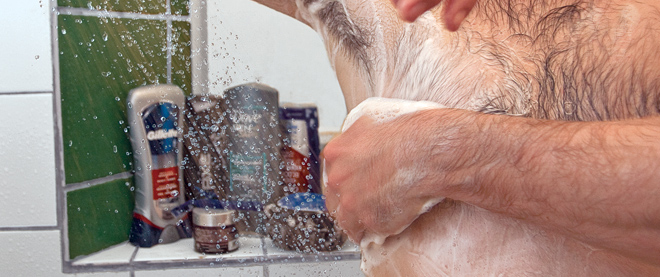Wash like a man
The soap industry is in a lather over its new male customers
Share

Gillette made its first razor in 1902—a year after its founder, inventor King Camp Gillette, was awarded a patent for the world’s first disposable blade. More than a century later, Gillette is ramping up for the launch of one of its newest creations: the Fusion ProGlide (with, count ’em, five ultra-thin blades), developed at its innovation centre, where experts assess over 20,000 shaves a year. “We have more Ph.D.s than MIT and most of the Ivy League schools put together working on this product,” boasts Derek Baker, a Gillette spokesperson.
That might sound a tad excessive, until you consider the stakes involved in the now-flourishing men’s grooming industry. Packaged Facts, a U.S. market research firm, valued the industry at US$19.7 billion in 2009, and estimates it will grow to US$28 billion by 2014. Last year, in Canada alone, the men’s care industry pulled in $1.6 billion in total sales, according to the firm Datamonitor. And it’s not just the razor blades and deodorant sticks of yesteryear that are selling. Instead, traditionally female brands like Dove and Nivea are entering the men’s ring, pushing products like just-for-men sensitive skin body bars and thermal scrubs. “It’s a beautiful time to be a man—or at least to market to men,” opines Advertising Age, “as personal care marketers rev up for what looks to be the biggest array of product launches for men in nearly a decade, and maybe ever.”
Once upon a time, personal care goods were gender-neutral—generic, modest-smelling products that were marketed to families. But lately, there’s been what marketers call a “genderization.” And there’s no place where that’s more apparent than the toiletry aisle. It’s toiletries—body wash, hair care and skin care—that is the fastest growing product category for men. “Men are increasingly demanding products that are specifically targeted at them [instead of] borrowing from their spouse,” says a Datamonitor report.
Personal care companies are answering this call with a slew of manlier-than-thou merchandise. Gillette now sells a clinical-strength deodorant with “technology?.?.?.?that doesn’t exist in females lines.” Dove, whose Campaign for Real [women’s] Beauty earned it accolades, now has a Men+Care line. Dial has moved beyond banal bar soap with Dial for Men “Magnetic,” which it markets as the first “pheromone-infused” body wash. And Axe has one-upped its snappy body sprays with a “Clean Your Balls” campaign, to promote its “dual-sided” Detailer shower tool.
All this raises the question of what exactly distinguishes a man’s product from a woman’s one. Fragrance is a huge part of it, says Sharon MacLeod, marketing director at Unilever, which owns Dove. But it’s more than smelling like Marine (Axe) or Swagger (Old Spice). There’s a convenience factor, too. “Dove Men+Care is a body wash and face wash in one,” MacLeod explains. She says that’s “appealing to men”—as opposed to women, who might prefer a separate body wash and facial cleanser. MacLeod says men also fancy “cleaner rinsing” body wash, since “they don’t want to feel as much moisturizer on their skin.” Robb Hadley, male grooming manager at Proctor & Gamble, says that skin sensitivity is an especially “important area” for men, who are increasingly likely to identify their facial skin as “sensitive.” Gillette’s sensitive products are often its best sellers, he adds.
But appealing to men’s sense of smell may be the easy part, next to the challenge of getting them shopping. Sears is piloting “men’s zones” in two of its Ontario stores—with the goal of making “shopping for personal care items less intimidating for men.” Wayne Peterson, Sears’ vice-president of cosmetics, says the “men’s zone” is strategically located next to men’s clothing and across from high-end beauty counters. Retailers know that it’s typically women who buy products for men. But Peterson hopes this new “playground of beauty products that knows no boundaries” will help draw men into stores.
And even if women are often doing the actual buying, it’s men who decide what products they want, says MacLeod. The trick is to hit men with the brand’s message while they’re at home. It’s no surprise, then, that the airwaves are suddenly filled with ads aimed at winning over the hearts and epidermises of Canadian dudes. Old Spice’s now-viral “I’m on a horse” commercial attacks “lady-scented body wash.” Gillette’s new ad cautions men against less ostensibly manly merchandise: “Just because it says it’s for a man doesn’t mean it is.” And Dove unveiled its “Manthem” during the most manly of spectacles: the Super Bowl.
Nuances aside, the men’s care market is now growing at the same rate as its female counterpart, insists Matthew Taylor, consumer business analyst at Datamonitor. And there are still opportunities left to be tapped—like “the anti-aging thing.” There is also a body of closet groomers that could yet be won over. A study commissioned by Dove found that while two-thirds of men in Canada use women’s personal care products, only a quarter are comfortable admitting to it.
And yet, some still dream of a day when the entire men’s market is itself obsolete. “I hope one day,” muses Peterson, “that a man and a woman can share a cream.”